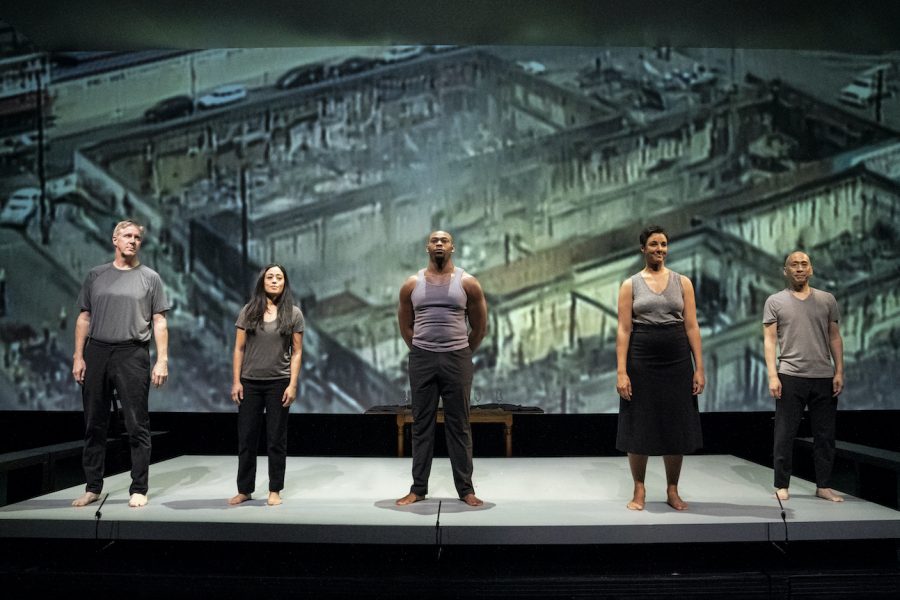Review: ‘Twilight: Los Angeles, 1992’ calls out America’s racial hypocrisy
Playing at The Signature Theatre, Anna Deveare Smith’s play about the Rodney King uprising is still tragically relevant.
Anna Deveare Smith’s play “Twilight: Los Angeles, 1992,” first premiered on Broadway in 1994. Now running at the Signature Theatre, the story of the Rodney King uprising is as relevant as ever. (Photo by Joan Marcus, Image courtesy of Signature Theatre)
November 2, 2021
In March 1991, officers from the Los Angeles Police Department kicked, manhandled and beat Black motorcyclist Rodney King on Interstate 210, sparking protests in which shops and neighborhoods were burned to the ground and many were injured or killed. Inspired by that anger and conflict, Anna Deavere Smith created the play “Twilight: Los Angeles, 1992,” which premiered for the first time in New York City at the Cort Theatre in 1994. Almost 30 years later, the Signature Theatre has revived “Twilight,” giving the piece a new life while maintaining the messaging that came across so strongly when it first debuted.
Smith’s play presents transcriptions of interviews she conducted with people impacted by the beating of King and the following uprising. Usually performed as a one-woman show starring Smith herself, this production is the first version to feature an ensemble cast of five actors. Each actor embodies different players in the events following the protests; audiences hear from a Korean shop owner, a white truck driver, several protesters, an accused police officer and many others throughout the course of the play.
The stories of every character are brought to life on the Diamond Stage, a cozy theater that facilitates intimacy between the actors and the audience. Large screens surrounding the stage enhance the performance, displaying clips of protests and speeches from important political figures like former President George H.W. Bush. The screens also show the names of each character before an actor assumes a new role. However, unlike the screens that surround it, the stage is dressed very simply with a platform, a few chairs, some benches and occasionally a dining room table. Each of the five actors play multiple characters — all of whom are based on real people who were interviewed at the time of the riots and the Rodney King beating.
“[Smith] always declared her work as a search,” said Marcos Najera, Smith’s long-time colleague. “She asks audiences to come and participate and to do a lot of work.”
Najera recently taught one of Smith’s graduate classes at NYU and is very familiar with her work.
“In the 25 years I’ve been working with Anna, we’ve been trying to understand … what does it mean for us to be different from each other?” Najera said.
This question echoes throughout Smith’s work and is captured by the actors on stage. Each actor portrays characters that — for the most part — are racially similar to them, which renders the conversations raw, truthful and deeply personal for everyone involved.
“I had never seen myself on stage [before Smith],” Najera said. “I didn’t think I could belong to the American theater.”
In this production of “Twilight,” it becomes apparent why it is important to listen to the stories of everyone associated with monumental events, not just the privileged voices that are typically given the spotlight.
“Twilight” not only explores the tension between Rodney King and his police assailants but also between the Korean and Black populations of Los Angeles, the upper and lower classes, and the news media and protesters. This gives viewers a more complete understanding of the events of 1992.
“The show very much deals with the cyclical nature of the problematic things in our culture surrounding race, racism and police brutality,” said Tiffany Rachelle Stewart, a Tisch instructor and “Twilight” cast member who plays eight characters over the course of the show, including Rodney King’s aunt and California Democrat Rep. Maxine Waters.
Since its original production, “Twilight” was not only adapted for a larger cast but also changed to include a monologue about the 2020 murder of George Floyd and the impacts of the pandemic.
In 2021, we continue to grapple with the systemic racism and bigotry that plagued the nation in 1992; in many ways, nothing has changed. Sitting in the audience, I could feel the show’s anger directed at the complacency that existed then and still exists today. The feeling emanated from the stage. The racism in our justice system, the role of the media in villainizing Black protesters, the privileged leaders who have so much to say but no intention to fight for change, and even the glorification of white figures in these movements are all still a part of our systems. Nothing has fundamentally changed. When these two movements — the one in 1992 and the one in the present — are presented together in “Twilight,” it is clear we are nowhere closer to justice.
For this reason and many others, “Twilight” is a must-see for NYU students. The impactful storytelling and the incredible performances by the entire cast make for an essential piece of theater.
“Give yourself permission the day you come see this play,” Stewart said. “Be open and breathe through it.”
Contact Katie Brown at [email protected].



























































































































































